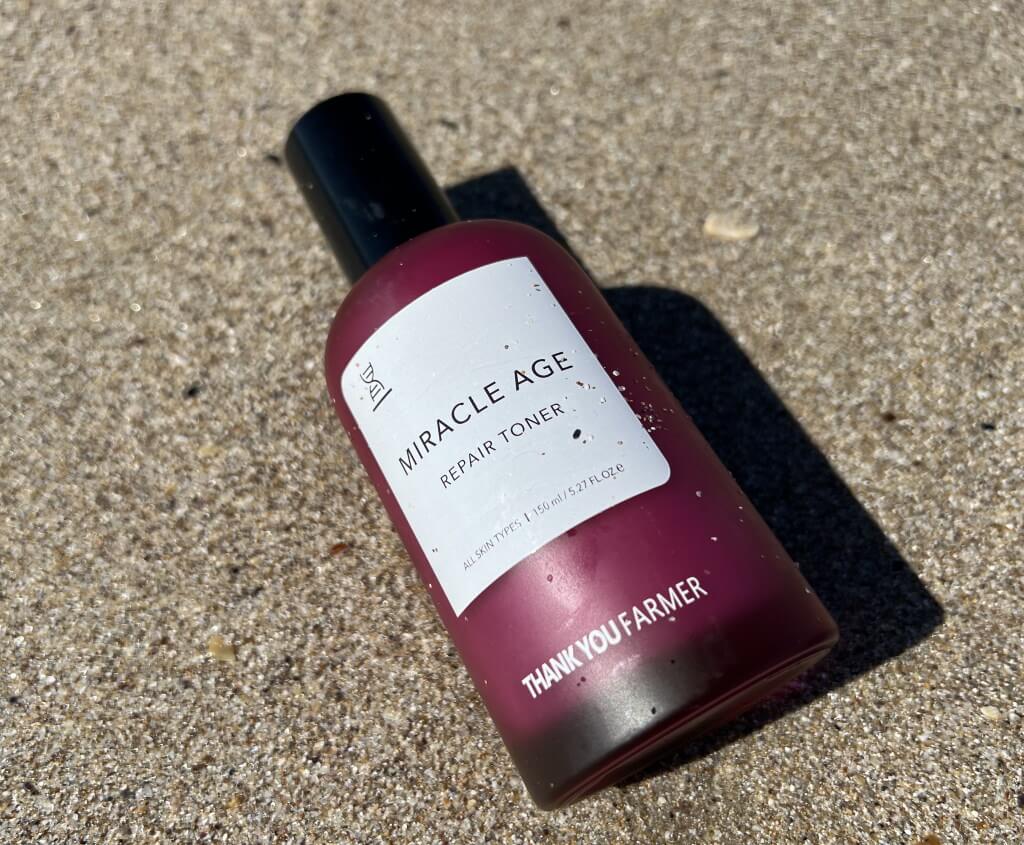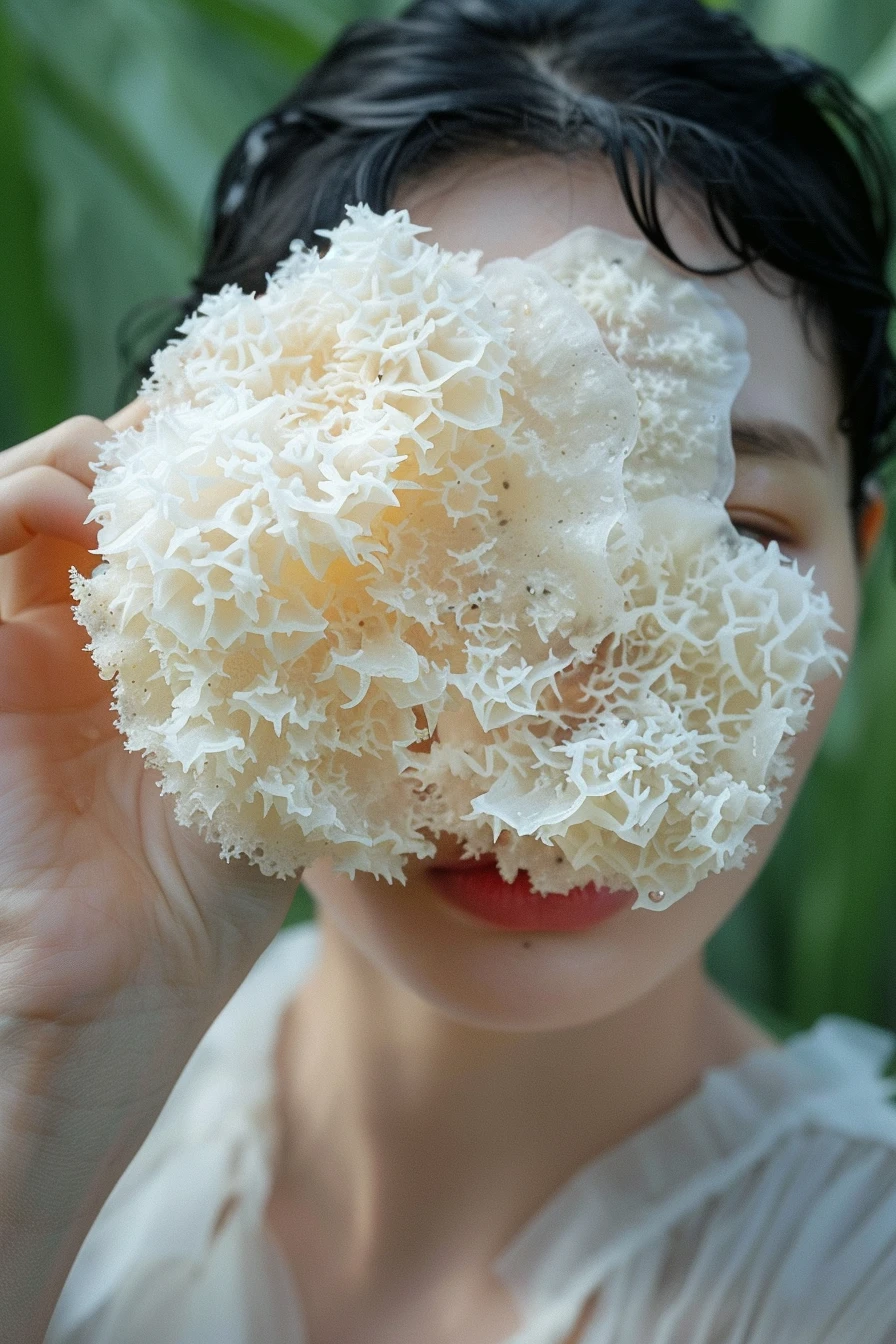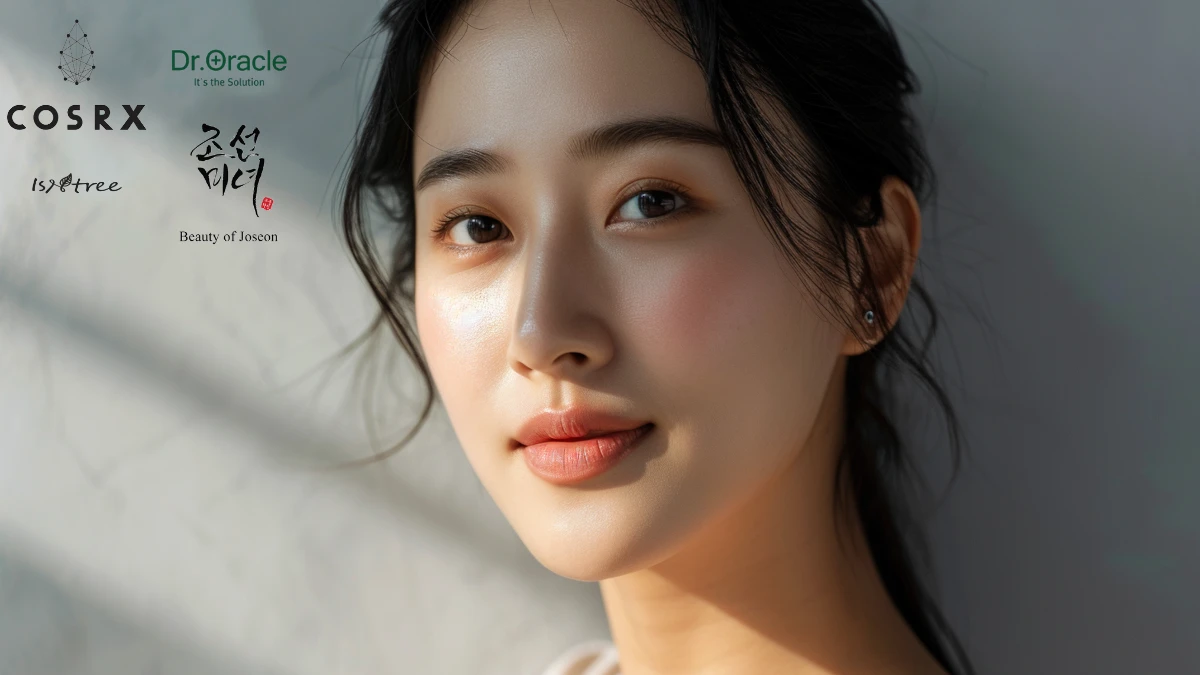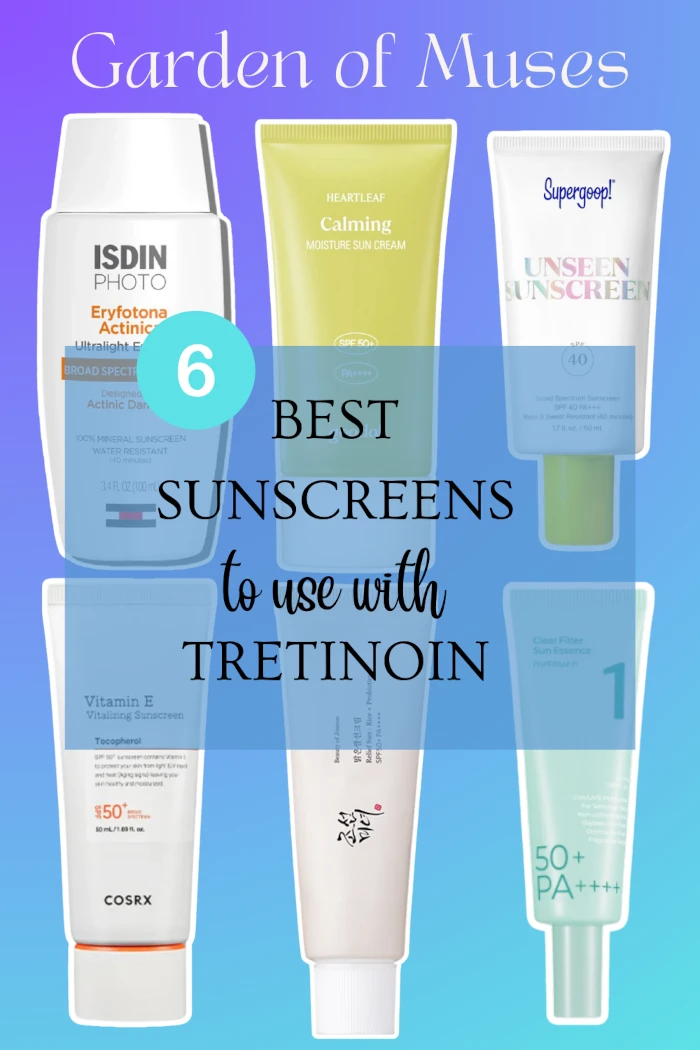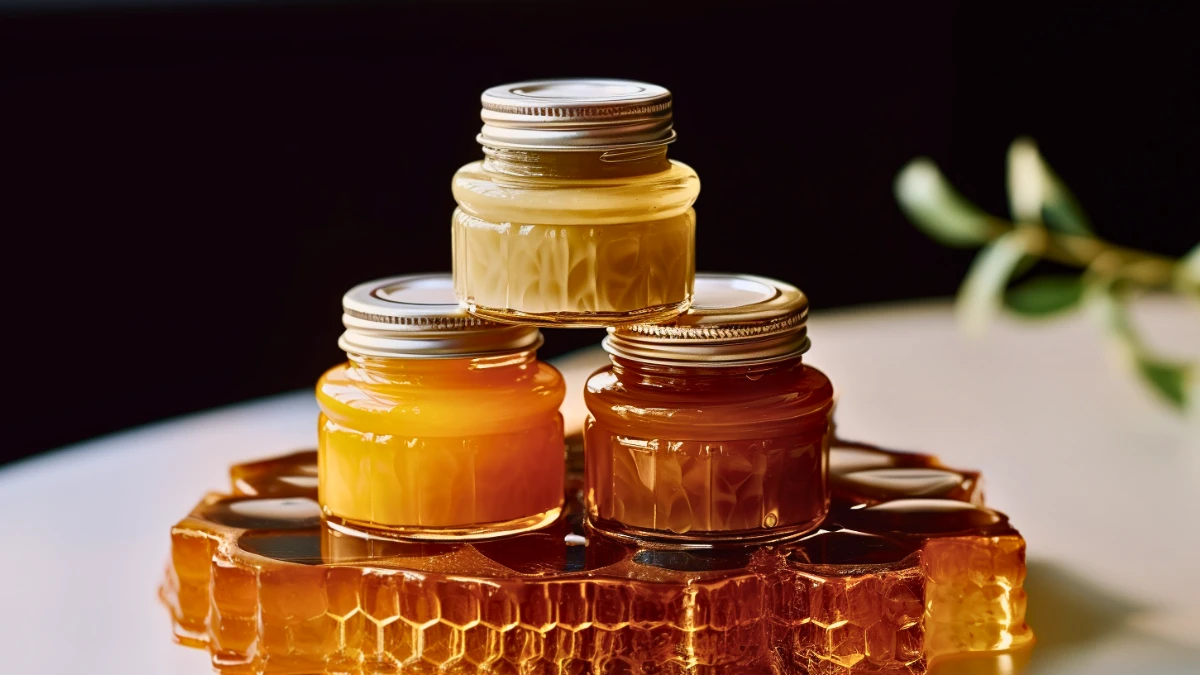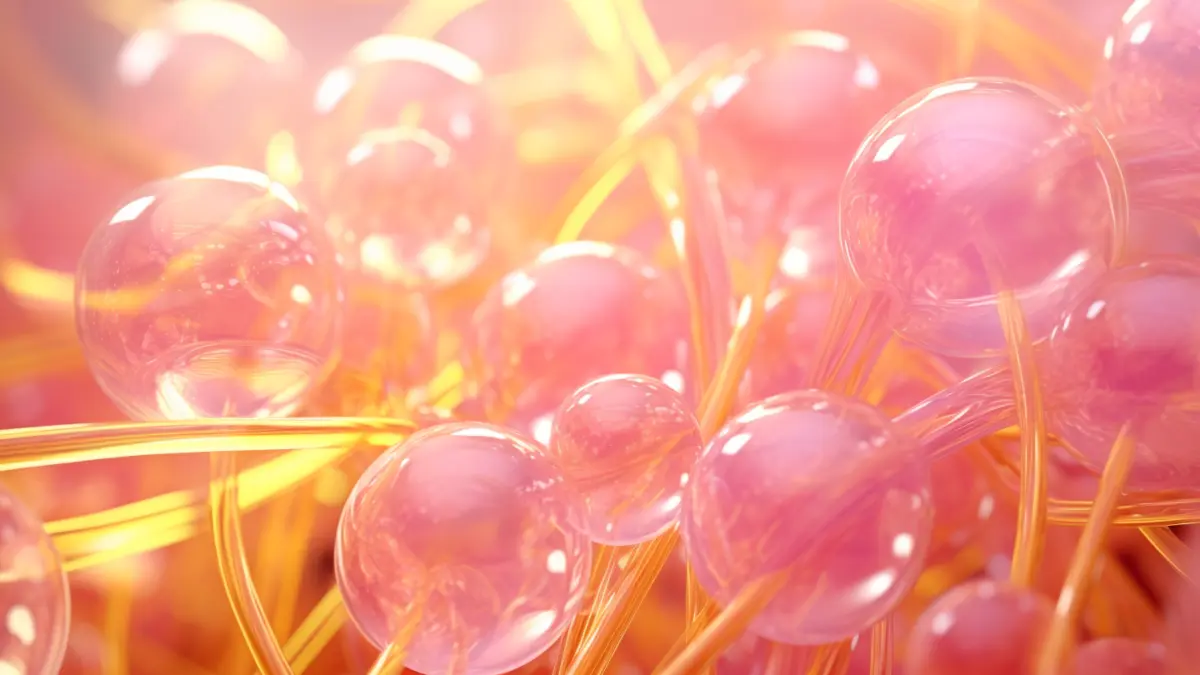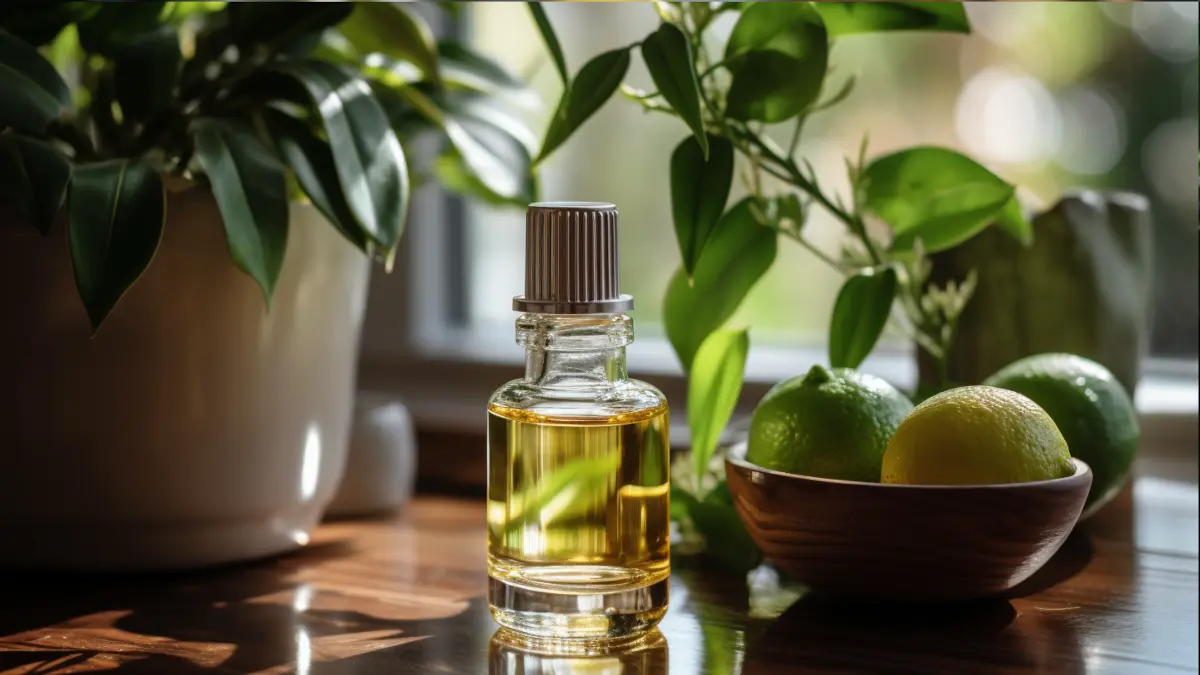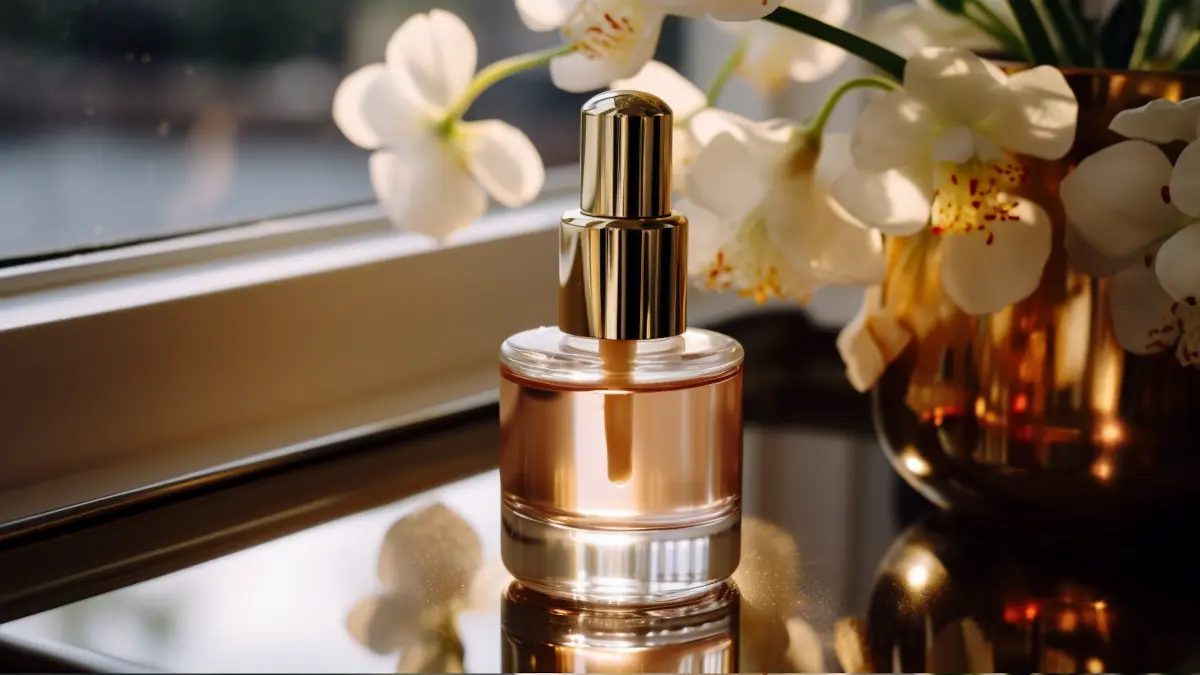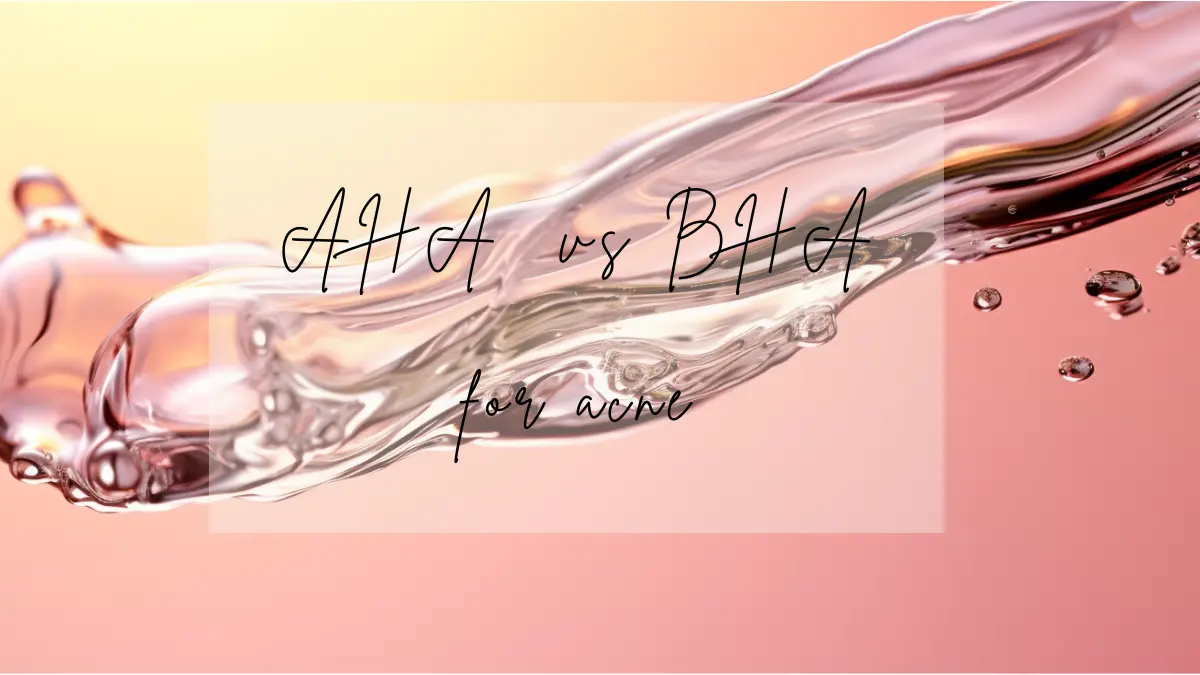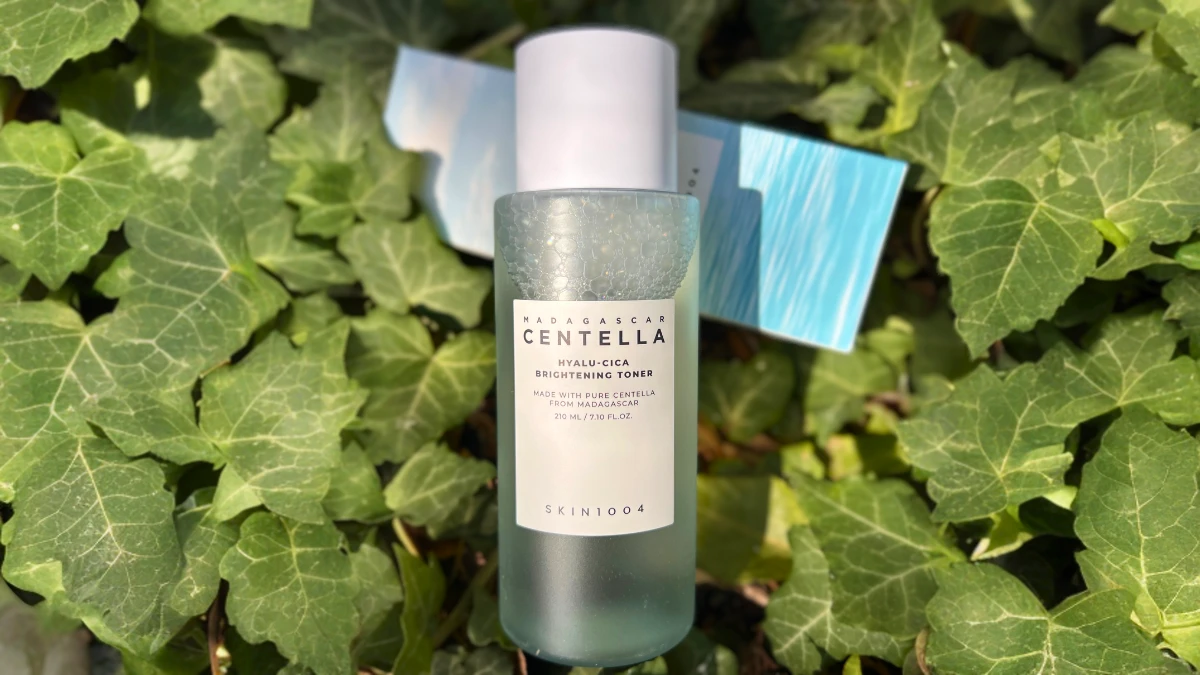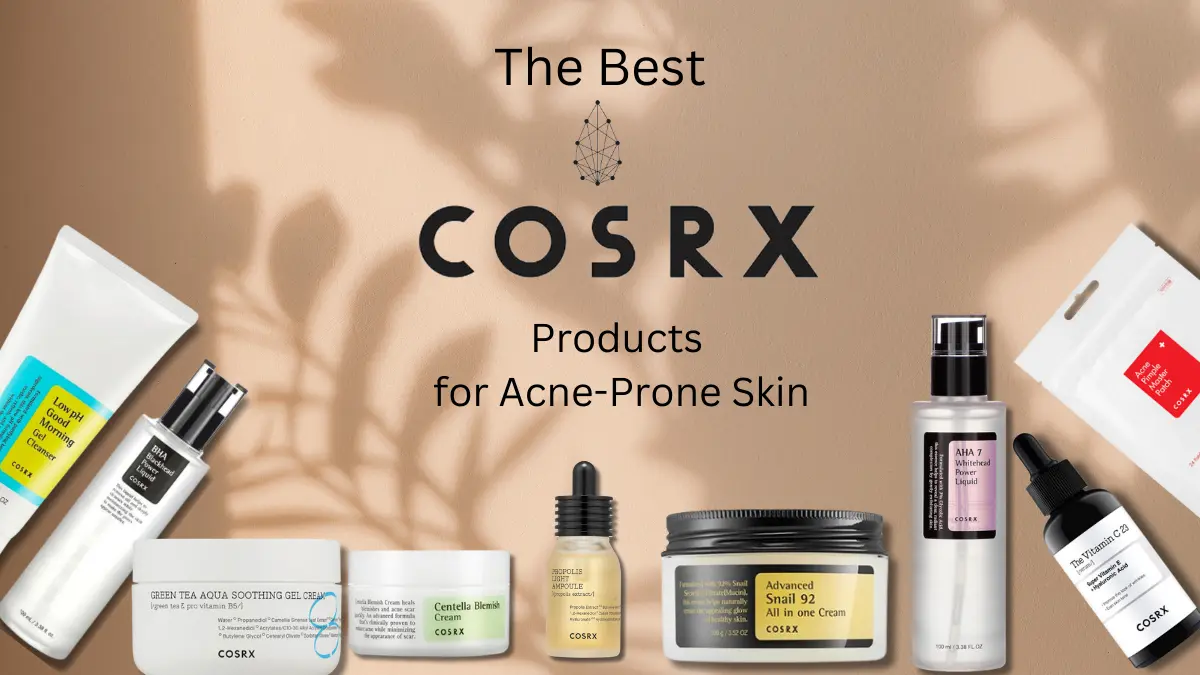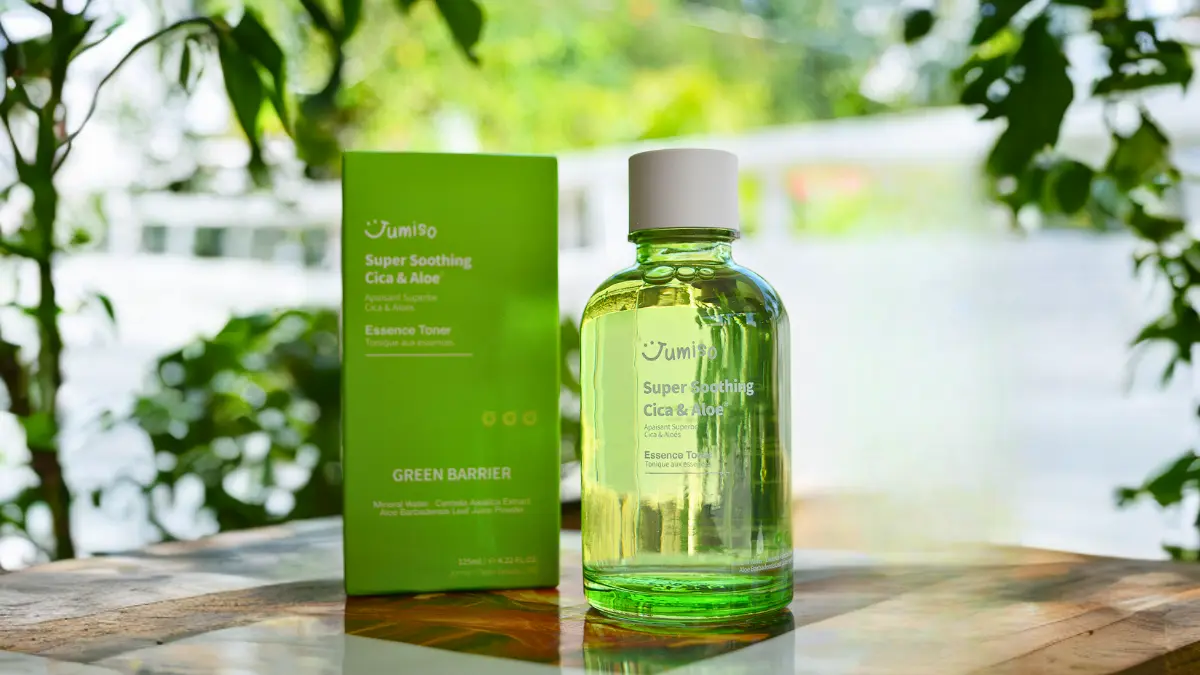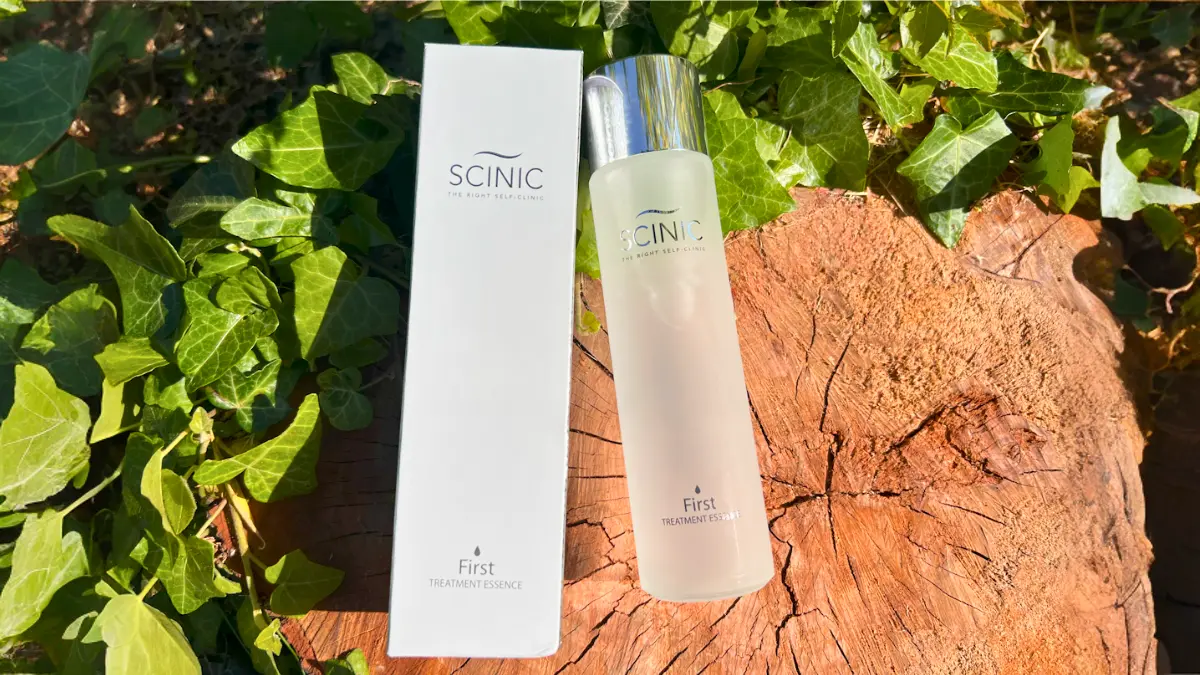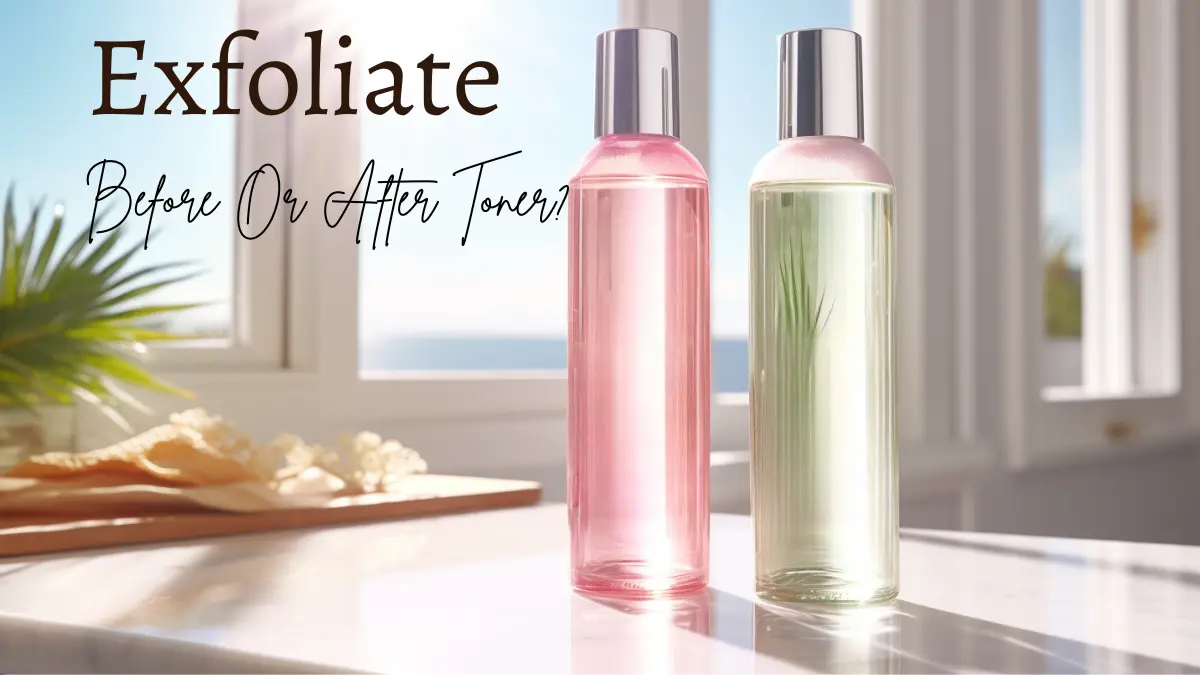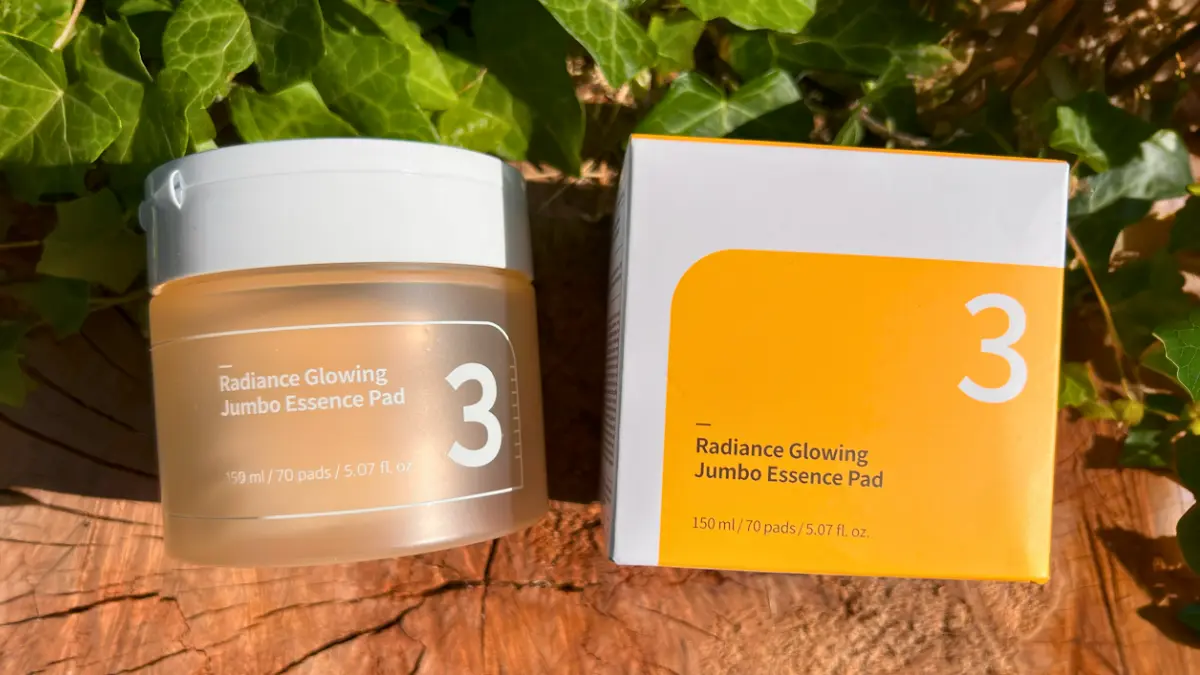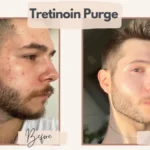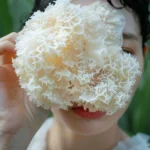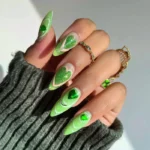Thank You Farmer Miracle Age Repair Toner was the first product I tried from this brand. I must admit that I was drawn to the lovely packaging and the cute company name.
Thank You Farmer Miracle Age Repair Toner Review, in a Nutshell:
Where to Buy the Thank You Farmer Miracle Age Repair Toner?

This toner is excellent; I’m telling you, you can go ahead and buy one; you won’t regret it. Still in doubt? Then, go ahead and read the rest of the review.
Price varies widely from 23$ to 40$ depending on where you shop and current deals. It’s a little on the pricey side if you ask me.
Shop the Thank You Farmer Miracle Age Repair Toner on Amazon*, YesStyle*, and StyleVana*.
The Thank You Farmer Brand
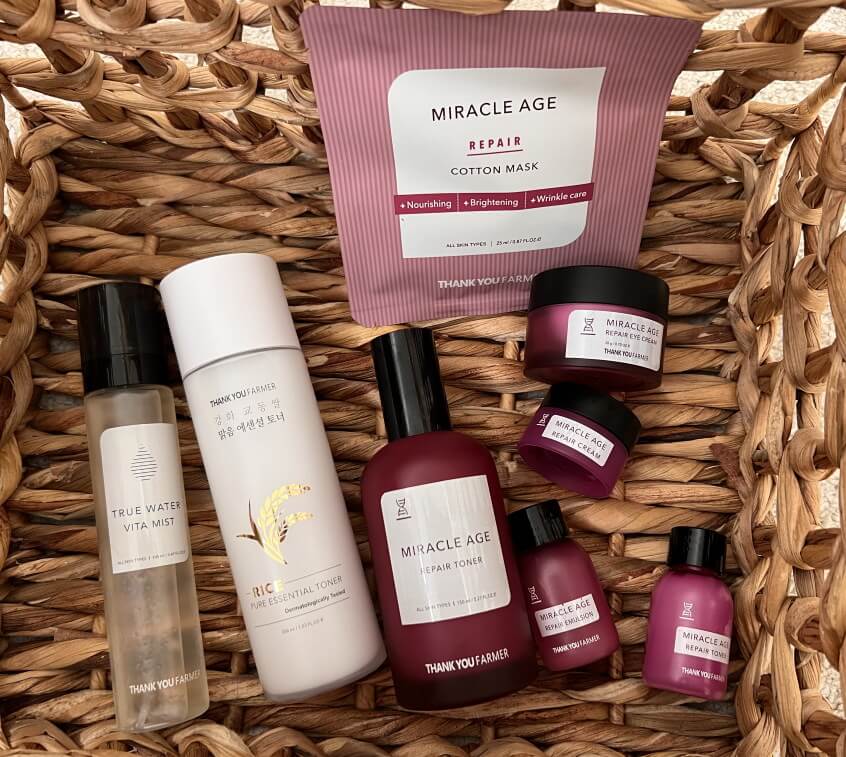
Thank You Farmer produces its natural products based on the philosophy of harmony with the skin’s nature, balance, health, and multi-functionality principle. Rooted in the farmer’s mentality with honest ingredients that help strengthen the skin naturally and still benefit nature.
Thank You Farmer Miracle Age Repair Toner
The Korean toner is part of the “miracle age” line. It is a nourishing and anti-age line with brightening and wrinkle-care dual functions.
Ideal Skin Type: Dry
The Thank You Farmer Miracle Age Repair Toner* is recommended for those with the following:
- Aging concerns – who isn’t?!
- Dull and dry skin with severe dryness
- Crisp and weak skin with dead skin cells
- Need for moisture recharge and a concentrated nutrition supply on busy mornings.
The absorption power is increased by what the Thank You Farmer website calls the “polymatrix structure”: a netted low-viscosity polymer moisturizing component combined with a milky texture nutrient oil.
Thank You Farmer Miracle Age Repair Toner Review Ingredients
Water, Caprylic/Capric Triglyceride, Butylene Glycol, Dimethicone, Glycerin, Niacinamide, Betaine, Dioscorea Japonica Root Extract, Arctium Lappa Root Extract, Phellinus Linteus Extract, Piper Methysticum Leaf/Root/Stem Extract, Portulaca Oleracea Extract, Pueraria Thunbergiana Root Extract, Glycyrrhiza Glabra (Licorice) Root Extract, Paeonia Lactiflora Root Extract, Cnidium Officinale Root Extract, Soluble Collagen, Aloe Barbadensis Leaf Juice, Hydrogenated Lecithin, Sodium Hyaluronate, Argania Spinosa Kernel Oil, Hydroxyethyl Acrylate/Sodium Acryloyldimethyl Taurate Copolymer, Squalane, Dimethicone/vinyl Dimethicone Crosspolymer, Lauryl Glucoside, Xanthan Gum, Polyglyceryl-2 Dipolyhydroxystearate, Polyquaternium-51, Glycosyl Trehalose, Adenosine, Sodium Laureth Sulfate, Hydrogenated Starch Hydrolysate, Raffinose, Biosaccharide Gum-1, Bisabolol, Lecithin, Panthenol, Dicaprylyl Carbonate, Sucrose Distearate, Ceramide Np, Folic Acid, Cholesterol, Tromethamine, Palmitoyl Pentapeptide-4, Polysorbate 60, Fragrance, 1,2-Hexanediol, Phenoxyethanol, Ethylhexylglycerin, Alpha-Isomethyl Ionone.
Ingredients referred from the Thank You Farmer website
Humectant/Moisturizing Active Herbs Brightening Fragrance Potential Irritant
Key Ingredients

Niacinamide
Niacinamide has been making a splash in the Western market over the last few years and has been splashing in Asian skincare for decades. This beauty powerhouse is the topical form of vitamin B3.
Several well-documented studies show that when used topically, niacinamide can:
- Strengthens the skin barrier by increasing ceramides and lipids, increasing stratum corneum thickness, and decreasing transepidermal water loss (TEWL);
- Improves the surface structure and smoothes out wrinkles;
- Boost hydration;
- Controls sebum production;
- Reduces acne;
- Calms redness and evens out red blotchiness;
- Improves skin texture;
- Lessens hyperpigmentation;
- Brightens sallowness of the skin;
- Treats rosacea, melasma and psoriasis.
Long story short, niacinamide does everything, and the good news is that it is well-tolerated by most skin types. To learn more, please read our Complete Guide on Niacinamide and How to Reduce Hyperpigmentation with Niacinamide.
Cnidium Officinale Root Extract
Cnidium Officinale Root Extract is an important oriental medicinal plant considered a great source of phthalides, polyphenols, and flavonoids. It acts as an antioxidant, skin-moisturizing, and whitening herb that combats inflammation in skin care.
Argania Spinosa Kernel Oil
Also called the Golden Solution, the oil helps give skin vitality and prevent moisture evaporation. It is suitable for anti-aging and firming.
Squalane
Squalane, in skincare, is nourishing and moisturizing, preventing wrinkles, scarring, sun damage, and pigmentation.
Dioscorea Japonica Root Extract (Yam root extract):
Also called Yam root extract, it is a phyto-mucin component that forms a natural barrier and moisturizes.
Portulaca Oleracea
Portulaca Oleracea is a wonderful source of antioxidants and fatty acids. It has also been found to reduce inflammation and improve the skin’s protective barrier.
Licorice
Licorice is a potent antioxidant that evens skin tone and soothes sensitive skin. Studies also have shown it acts as an anticarcinogenic.
Adenosine
- Anti-Wrinkle Benefits. Adenosine stimulates collagen production and down-regulates collagen degradation.
- Skin restoration. Adenosine promotes dermal wound healing and tissue repair.
- Soothing. Adenosine decreases inflammation of the skin often experienced by people with sensitive skin or acne.
Lecithin
Lecithin is a water-binding emollient with skin-restoring properties when used in high concentrations.
Sodium Hyaluronate
Sodium Hyaluronate is a natural moisturizing factor that strengthens the skin’s barrier. It has a smaller molecular size than hyaluronic acid, which can penetrate the skin better.
Read our guide on the Benefits of Ceramides for the Skin
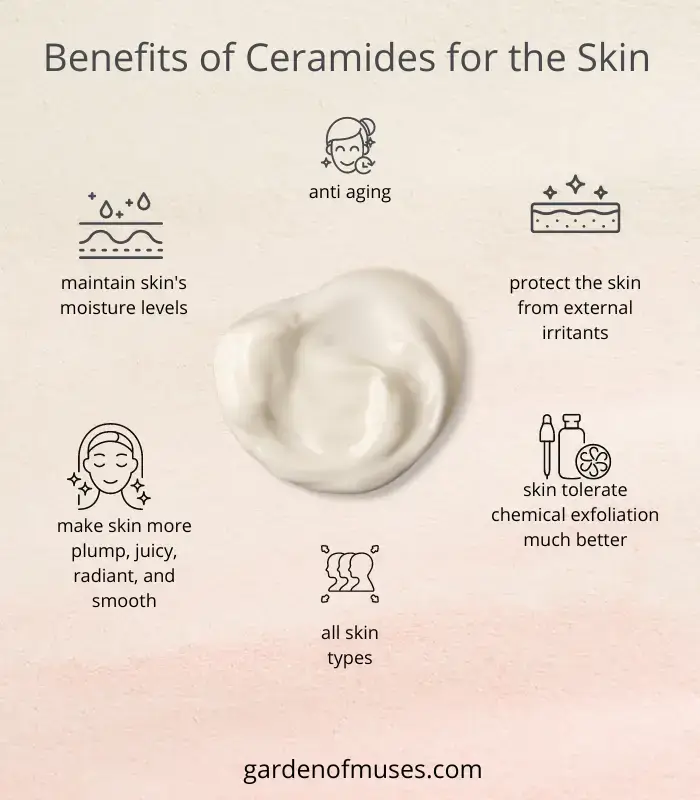
Ceramides
Ceramides are a family of lipids that account for 50% of the skin barrier (by weight), so they’re essential, right? Ceramides are crucial to:
- maintain the skin’s moisture levels;
- protect skin from external irritants, making skin more resilient;
- help make skin more plump, juicy, radiant, and smooth;
- makes skin tolerate chemical exfoliation much better;
- skin is less likely to become irritated;
- because they prevent dehydration, ceramides are a great anti-aging ingredient;
- regulate the cell cycle and apoptosis (regulated cell death);
- beneficial for all skin types.
Heralded as skincare heroes, ceramides can now be found in cleansers, toners, serums, masks, moisturizers, and even hand creams.
Ceramides are golden children; they get along with everyone (unlike vitamin C and A, those brats). They go exceptionally well with plant oils rich in linoleic acid and cholesterol.
Peptides
I believe this is one of the most underrated ingredients in anti-aging skincare. Wrinkles form when the skin loses elasticity and collagen. Peptides are cell communicators that alert your skin to collagen loss so your body can produce more collagen. Theoretically, when peptides are applied topically, they penetrate your skin without damaging your cells so that your body receives the “More collagen, bro!” message, thus stimulating more collagen production wherever it is applied.
Palmitoyl Pentapeptide-4 Peptides did not earn notoriety in skincare until the beginning of 2000, when Palmitoyl Pentapeptide-4 was launched, proposing to reduce facial wrinkles. It is among the most commonly studied peptides in wrinkle attenuation and skin filling.
The Thank You Farmer Miracle Age Repair Toner* offers everything for dry skin! I give it a thumbs up!
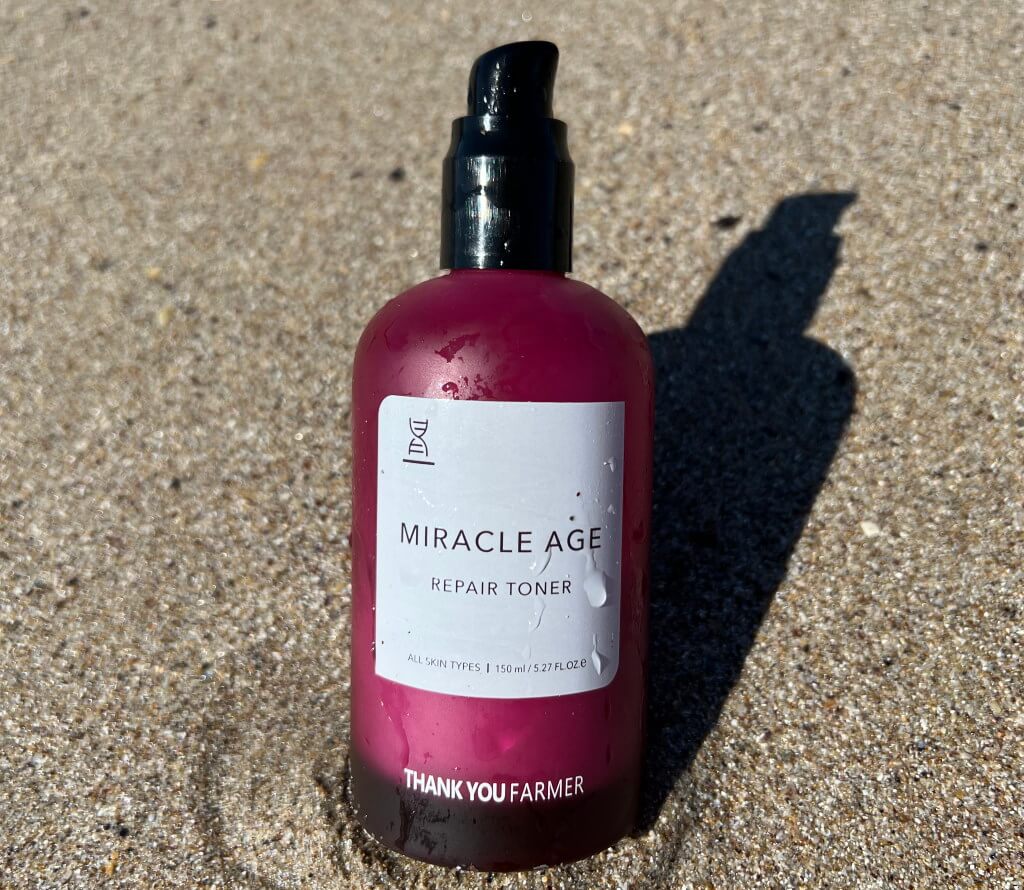
Packaging
Thank You Farmer Miracle Age Repair Toner comes in a purple glass bottle, is slightly transparent, and has a luxurious design and feel.
I love that the Thank You Farmer Miracle Age Repair Toner uses a pump bottle mechanism, not a dropper mechanism. Whilst I don’t mind a dropper, I find the pump quite quick and easy to use in the morning. The packaging is convenient because the usage is precise; there’s no spillage or overuse. There is no waste due to unnecessary cotton pads.
The content is protected due to lack of air contact, so no bacterial contamination exists.
One pump is generally enough to use on my face for daytime and evening; a little does go a long way with this toner. Therefore, the 150ml toner lasts a lot.
The bottle is not travel-friendly; it is very heavy and can break. For traveling, I recommend buying the Thank You Farmer Miracle Age Repair Travel Set. The little containers can be sanitized and refilled with the original products.
Scent
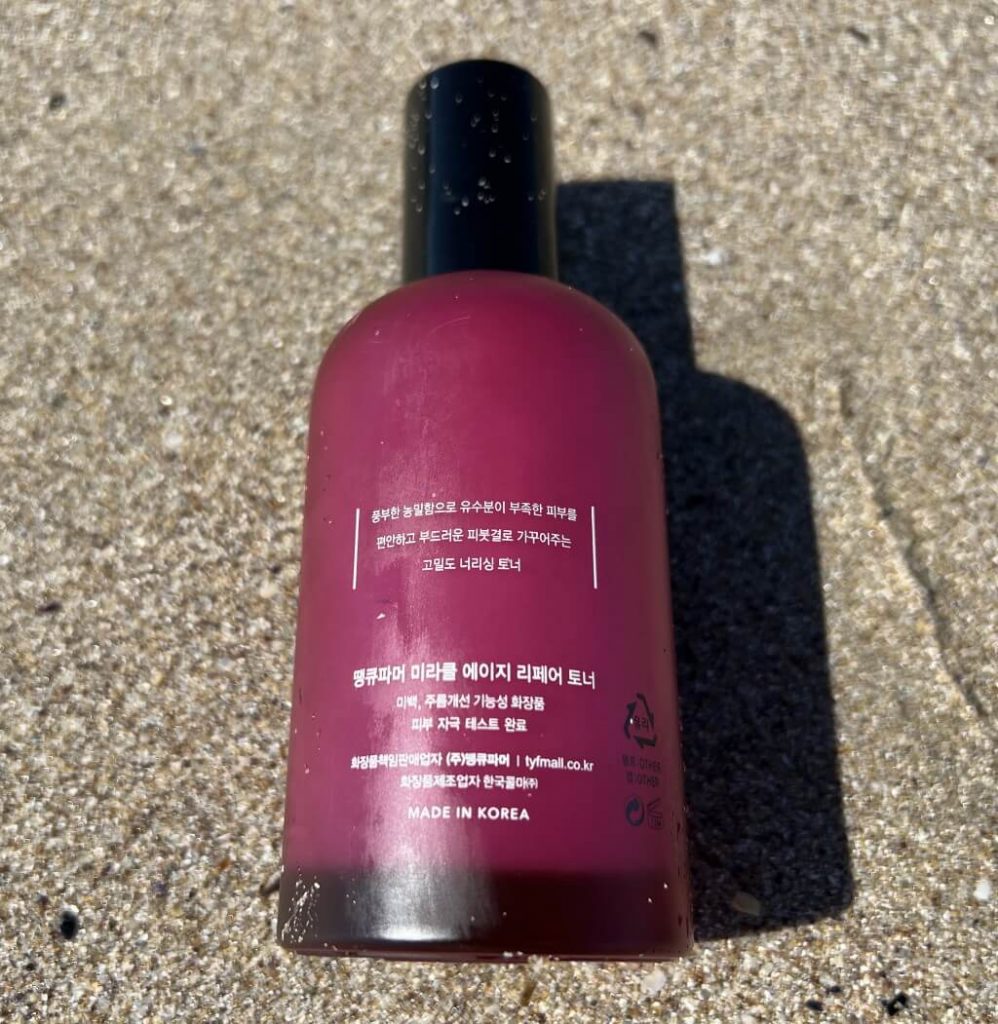
A floral, luxurious scent. It feels therapeutic for the mind, also.
Texture
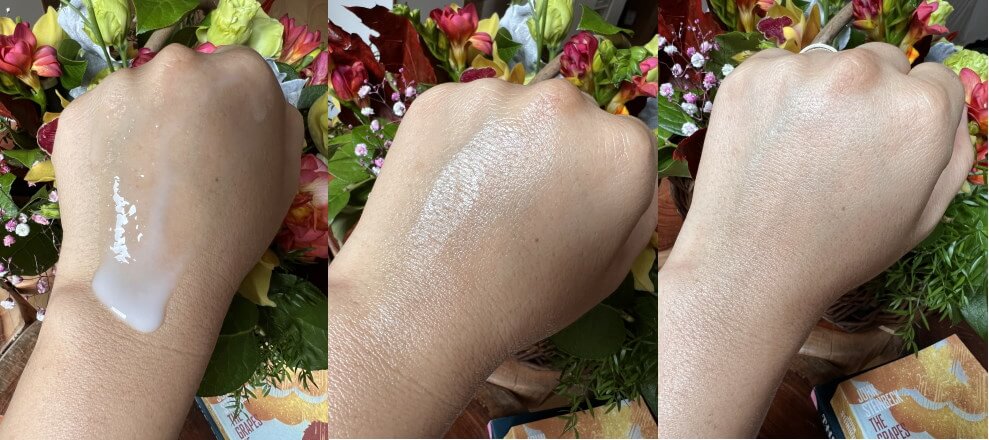
Mia Peterson for Garden of Muses
The Miracle Age Repair Toner has a thick viscous, chewy texture. The color is slightly whitish but blends in immediately. The Thank You Farmer Miracle Age Repair Toner is not sticky, nor does it leave any stickiness.
The absorption is divine, leaving it soft and supple.
My Experience with Miracle Age Repair Toner Review
My skin type and concerns
I have a normal – dry skin type, and I live in a temperate continental climate with cold & dry winters and hot &dry summers.
When I started using the Thank You Farmer Miracle Age Repair Toner, my skin was extremely dehydrated due to a lack of care and a harsh, dry winter.
The results had the wow factor!
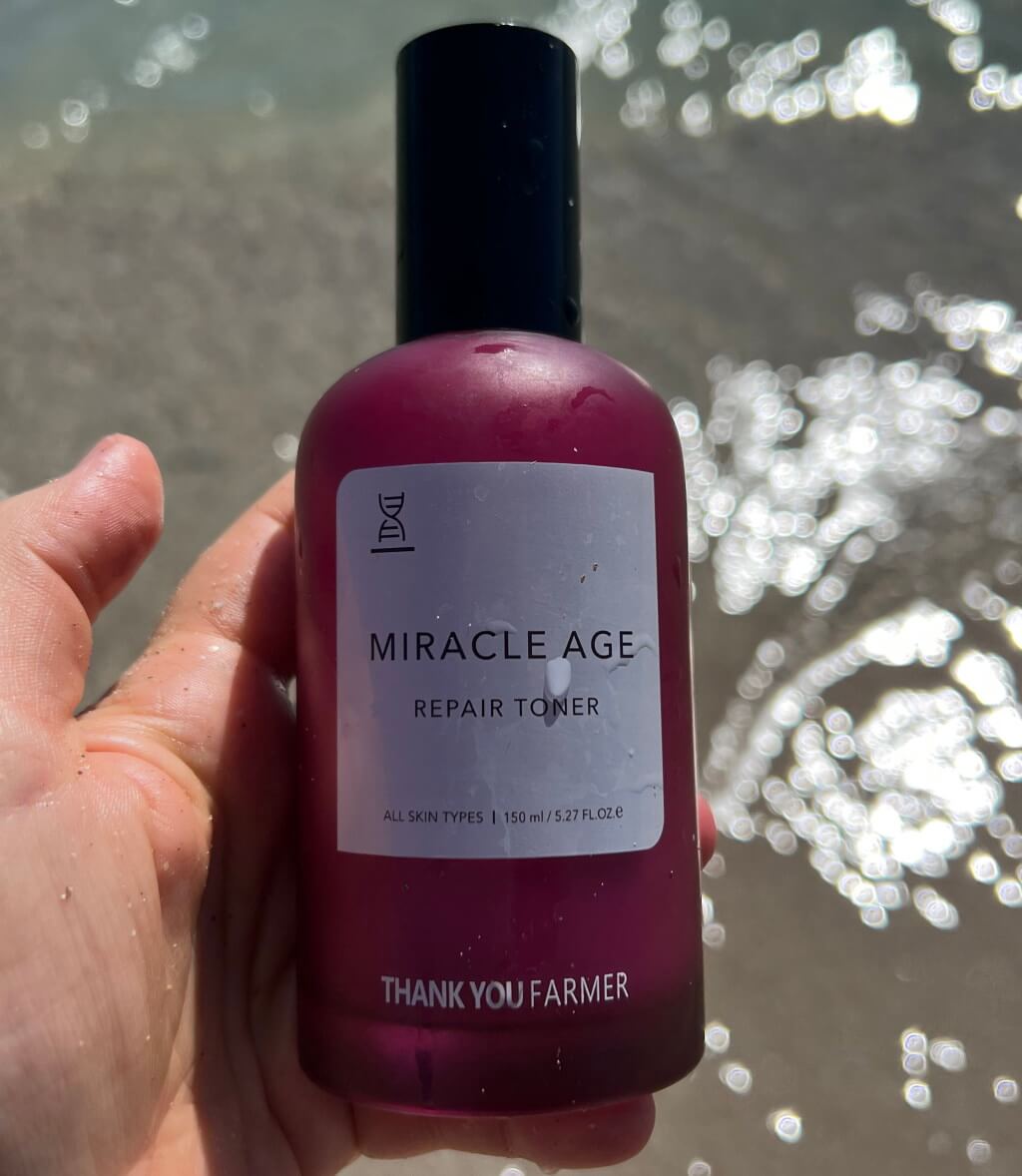
Thank You Farmer Miracle Age Repair Toner is genuinely hydrating, making me feel like my face had a glass of water. My skin feels plump and firm. My skin becomes glowy in a fresh and supple way, not in a greasy, slimy way.
It diminished the crepey skin and fine wrinkles around my eyes. Although packed with many active ingredients, it doesn’t sting my eyes, allowing me to apply it all over my face.
Thank You Farmer Miracle Age Repair Toner has minimized the pores on my face. I noticed this, especially on my nose, and it was pleasantly unexpected.
I use it morning and night. It is my HOLY GRAIL toner. We shall never part, and I hope it will never be reformulated.
The multi-purpose toner works wonderfully when you’re in a hurry—but doing your entire routine boosts the skin’s adhesiveness for the next care product.
Although destined for skin types on the dryer side, I feel it can benefit anyone. I think it can be used as an emulsion for oily skin types. If you’re looking for a brightening milky toner, I recommend you try Thank You Farmer Rice Pure Essential Toner.
How I use the Thank You Farmer Miracle Age Repair Toner
- Start by cleansing;
- First essence, exfoliating toner, mists, and other hydrating toners if in need of more pampering;
- Two pumps into the fingertips of your hand and spread on the entire face area, including the eyes and lips area;
- I pat the Thank You Farmer Miracle Age Repair Toner on my face instead of swiping with a cotton pad;
- One more pump for neck and décolletage.
- I like to give my skin a full minute to fully absorb this power toner before moving on;
- At night, I add a serum;
- Carry on with a moisturizing cream, lotion, or emulsion as desired;
- In the mornings, don’t forget SPF;
I loved the toner so much that I repurchased it and tried everything from the Thank You Farmer Miracle Age line: eye cream, serum, emulsion, cream, and mask. Reviews will be coming up soon.
Related story: Guide to correctly layering chemical exfoliants and hydrating toners
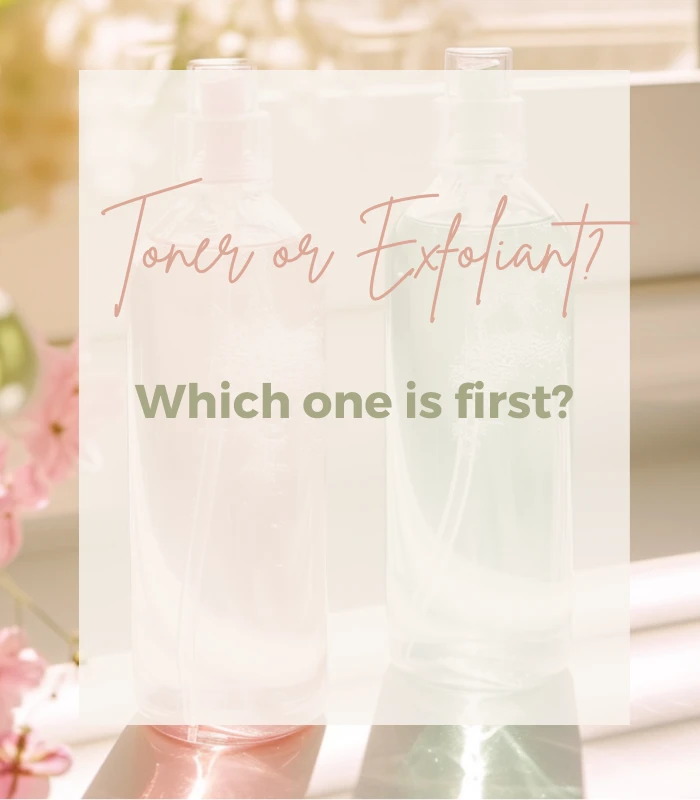
Pros
- truly hydrates
- smells amazing
- crepey skin gone
Cons
- not travel friendly
- pricey
Verdict
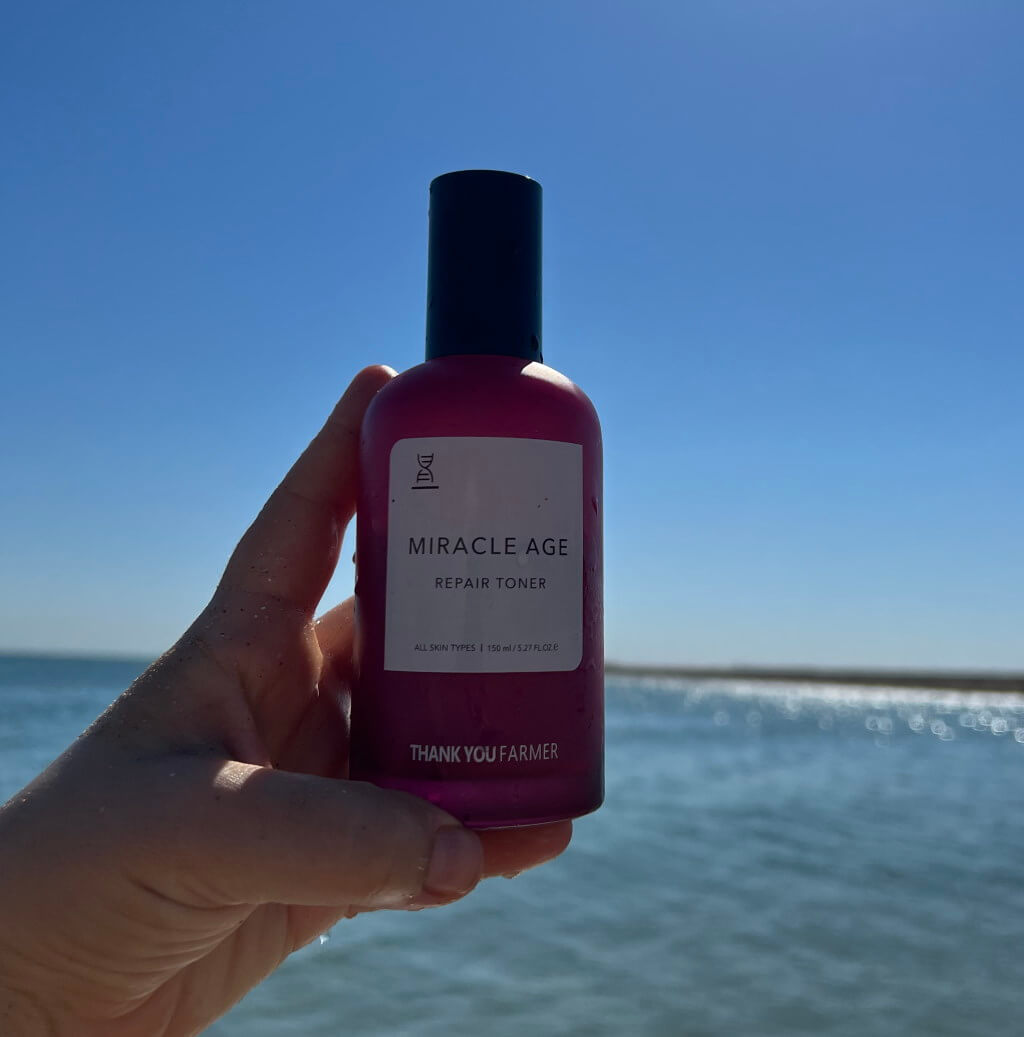
The Thank You Farmer Miracle Age Repair Toner is a multi-purpose product doing the job of skin (toner in Asia), lotion, and essence all in one bottle.
Will I repurchase Miracle Age Repair Toner?
YES. It is my holy grail, and I always have one more unopened bottle on my shelf.
Rating 5/5
Shop for Thank You Farmer Miracle Age Repair Toner
Unfortunately, this product is not so readily available in the US. I found it on Amazon*, and on trusted international websites such as: YesStyle* and StyleVana* (*affiliate links).
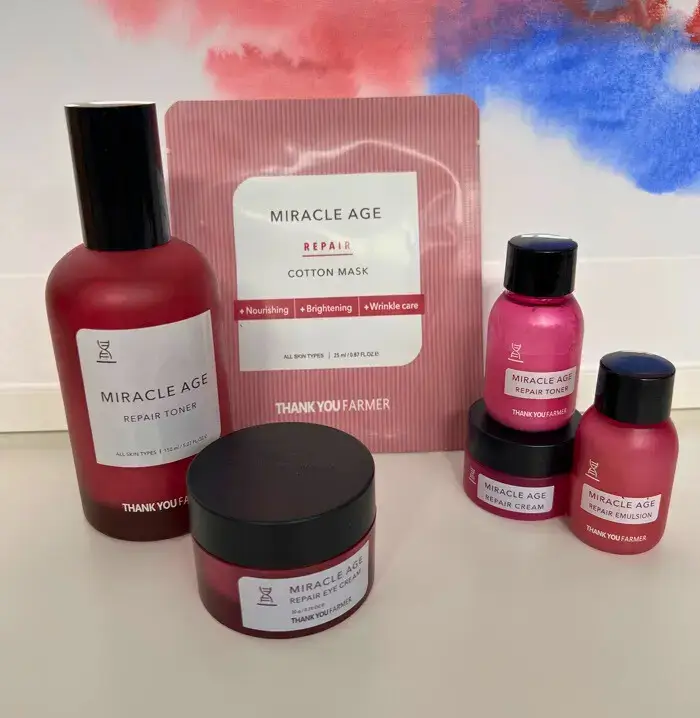
The price varies from 23$ to 40$ depending on where you shop and current deals.
Lastly, I was not paid for this review or received it as a gift.
As always, you do you; be kind to your skin and yourself! Remember that every person’s skin and skin type is different, so what might work for me might not work for you, and vice versa. So, before adding a new product to your skincare routine, it pays to do a little research first.
Before adding the Thank You Farmer Miracle Age Repair Toner to your skincare regimen, ensure you are not allergic to it or its ingredients. You should also consult your doctor if you are pregnant or breastfeeding or have any medical conditions or medications that may interact with the Thank You Farmer Miracle Age Repair Toner. Always do a patch test before applying the Thank You Farmer Miracle Age Repair Toner on your skin to avoid adverse reactions.
I am not a dermatologist or licensed aesthetician, but I have sufficient experience and knowledge I gained by testing multiple products and self-exploration. Unsure? Best to consult your dermatologist.
Happy shopping, and don’t forget the sunscreen! Here’s to great skin in [current_year]!
Show Me Proof
- Q Li, H Fang, E Dang, G Wang, The role of ceramides in skin homeostasis and inflammatory skin diseases, Journal of Dermatological Science, Volume 97, Issue 1, 2020, https://doi.org/10.1016/j.jdermsci.2019.12.002.
- Coderch, L., López, O., de la Maza, A. et al. Ceramides and Skin Function. Am J Clin Dermatol 4, 107–129 (2003). https://doi.org/10.2165/00128071-200304020-00004.
- Uchida Y. Ceramide signaling in mammalian epidermis. Biochim Biophys Acta. 2014 Mar;1841(3):453-62. doi: 10.1016/j.bbalip.2013.09.003. Epub 2013 Sep 19. PMID: 24055887; PMCID: PMC3943494.
- Cha, H. J., He, C., Zhao, H., Dong, Y., An, I., An, S.”Intercellular and intracellular functions of ceramides and their metabolites in skin (Review)“. International Journal of Molecular Medicine 38, no. 1 (2016): 16-22. https://doi.org/10.3892/ijmm.2016.2600
- Kang TH, Yoon G, Kang IA, Oh HN, Chae JI, Shim JH. Natural Compound Licochalcone B Induced Extrinsic and Intrinsic Apoptosis in Human Skin Melanoma (A375) and Squamous Cell Carcinoma (A431) Cells. Phytother Res. 2017 Dec;31(12):1858-1867. doi: 10.1002/ptr.5928. Epub 2017 Oct 13. PMID: 29027311.
- Tanno, O., Y. Ota, N. Kitamura, T. Katsube, and S. Inoue. “Nicotinamide increases biosynthesis of ceramides as well as other stratum corneum lipids to improve the epidermal permeability barrier.” British Journal of Dermatology 143, no. 3 (2000): 524-531.
- Mohammed, D., J. M. Crowther, P. J. Matts, J. Hadgraft, and M. E. Lane. “Influence of niacinamide containing formulations on the molecular and biophysical properties of the stratum corneum.” International journal of pharmaceutics 441, no. 1-2 (2013): 192-201.
- Snaidr, Victoria A., Diona L. Damian, and Gary M. Halliday. “Nicotinamide for photoprotection and skin cancer chemoprevention: A review of efficacy and safety.” Experimental dermatology 28 (2019): 15-22.
- Gehring, W. “Nicotinic acid/niacinamide and the skin.” Journal of Cosmetic Dermatology 3, no. 2 (2004): 88-93.
- Soma, Yoshinao, Masato Kashima, Akiko Imaizumi, Hideto Takahama, Tamihiro Kawakami, and Masako Mizoguchi. “Moisturizing effects of topical nicotinamide on atopic dry skin.” International journal of dermatology 44, no. 3 (2005): 197-202.
- Draelos, Zoe Diana, Akira Matsubara, and Kenneth Smiles. “The effect of 2% niacinamide on facial sebum production.” Journal of Cosmetic and Laser Therapy 8, no. 2 (2006): 96-101.
- Shahmoradi, Zabiolah, Farib Iraji, Amir Hossein Siadat, and Azamosadat Ghorbaini. “Comparison of topical 5% nicotinamid gel versus 2% clindamycin gel in the treatment of the mild-moderate acne vulgaris: A double-blinded randomized clinical trial.” Journal of Research in Medical Sciences: The Official Journal of Isfahan University of Medical Sciences 18, no. 2 (2013): 115.
- Ungerstedt, J. S., M. Blombäck, and T. Söderström. “Nicotinamide is a potent inhibitor of proinflammatory cytokines.” Clinical & Experimental Immunology 131, no. 1 (2003): 48-52.
- Bissett, D. L., K. Miyamoto, P. Sun, J. Li, and C. A. Berge. “Topical niacinamide reduces yellowing, wrinkling, red blotchiness, and hyperpigmented spots in aging facial skin 1.” International journal of cosmetic science 26, no. 5 (2004): 231-238.
- Darlenski, Razvigor, Jana Kazandjieva, Nikolai Tsankov, and Joachim W. Fluhr. “Acute irritant threshold correlates with barrier function, skin hydration and contact hypersensitivity in atopic dermatitis and rosacea.” Experimental dermatology 22, no. 11 (2013): 752-753.
- Navarrete-Solís, Josefina, Juan Pablo Castanedo-Cázares, Bertha Torres-Álvarez, Cuauhtemoc Oros-Ovalle, Cornelia Fuentes-Ahumada, Francisco Javier González, Juan David Martínez-Ramírez, and Benjamin Moncada. “A double-blind, randomized clinical trial of niacinamide 4% versus hydroquinone 4% in the treatment of melasma.” Dermatology research and practice 2011 (2011).
- Namazi, Mohammad Reza. “Nicotinamide: a potential addition to the anti‐psoriatic weaponry.” The FASEB journal 17, no. 11 (2003): 1377-1379.
- Zhao, Hengguang, Shuang Li, Fuling Luo, Qian Tan, Hui Li, and Weikang Zhou. “Portulaca oleracea L. aids calcipotriol in reversing keratinocyte differentiation and skin barrier dysfunction in psoriasis through inhibition of the nuclear factor κB signaling pathway.” Experimental and Therapeutic Medicine 9, no. 2 (2015): 303-310.
- Uddin, Md Kamal, Abdul Shukor Juraimi, Md Eaqub Ali, and Mohd Razi Ismail. “Evaluation of antioxidant properties and mineral composition of purslane (Portulaca oleracea L.) at different growth stages.” International journal of molecular sciences 13, no. 8 (2012): 10257-10267.
- Uddin, Md Kamal, Abdul Shukor Juraimi, Md Sabir Hossain, Most Nahar, Altaf Un, Md Eaqub Ali, and M. M. Rahman. “Purslane weed (Portulaca oleracea): a prospective plant source of nutrition, omega-3 fatty acid, and antioxidant attributes.” The Scientific World Journal 2014 (2014).
- Stallings, Alison F., and Mary P. Lupo. “Practical uses of botanicals in skin care.” The Journal of clinical and aesthetic dermatology 2, no. 1 (2009): 36.
- Fiume, Z. “Final report on the safety assessment of Lecithin and Hydrogenated Lecithin.” International journal of toxicology 20 (2001): 21-45.
- Lupo, Mary P., and Anna L. Cole. “Cosmeceutical peptides.” Dermatologic therapy 20, no. 5 (2007): 343-349.
- Gorouhi, F., and H. I. Maibach. “Role of topical peptides in preventing or treating aged skin.” International journal of cosmetic science 31, no. 5 (2009): 327-345.
- Robinson, L. R., N. C. Fitzgerald, D. G. Doughty, N. C. Dawes, C. A. Berge, and D. L. Bissett. “Topical palmitoyl pentapeptide provides improvement in photoaged human facial skin 1.” International journal of cosmetic science 27, no. 3 (2005): 155-160.
- Ku, Jin Mo, Se Hyang Hong, Hyo In Kim, Min Jeong Kim, Kyungyul Mok, Yong Cheol Shin, and Seong-Gyu Ko. “Cnidium officinale Makino Promotes Skin Health via Anti-Inflammation Processes in Various Skin Cell Lines.” (2020).
- Adil, Muhammad, Xiuxia Ren, and Byoung Ryong Jeong. “Light elicited growth, antioxidant enzymes activities and production of medicinal compounds in callus culture of Cnidium officinale Makino.” Journal of Photochemistry and Photobiology B: Biology 196 (2019): 111509.
- Scalbert, Augustin, Ian T. Johnson, and Mike Saltmarsh. “Polyphenols: antioxidants and beyond.” The American journal of clinical nutrition 81, no. 1 (2005): 215S-217S.
- Abella, M. L. “Evaluation of anti‐wrinkle efficacy of adenosine‐containing products using the FOITS technique.” International journal of cosmetic science 28, no. 6 (2006): 447-451.
- Cronstein, Bruce N. “Adenosine receptors and wound healing.” TheScientificWorldJOURNAL 4 (2004): 1-8.
